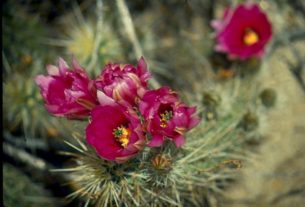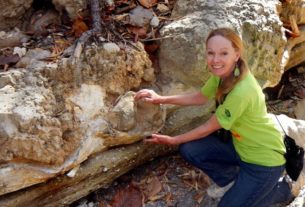The following extract is taken (with the author’s permission) from the English edition of Western Mexico: A Traveller’s Treasury by Tony Burton (3rd edition, Perception Press, 2001), available from Sombrero Bookss
The least touristy town along the northern lakeshore, Jocotepec has a distinctive charm all of its own.
The large central plaza which lies in the shadow of the towering hills is as attractive as any in the Riviera. It has a central bandstand and several monuments including one in celebration of the 500th anniversary of Columbus’ first voyage, and a stone disc, engraved with the town’s coat-of-arms, erected to commemorate the 450th anniversary of the official founding of the town in 1529.
On Sunday evenings, the plaza is transformed into a scene of intense social activity as the townspeople gather to participate in the weekly “paseo” in which young ladies, elegantly attired, walk clockwise around the central bandstand, whilst young men walk in the opposite direction. When a young man sees a young lady he is “interested in”, he will give her a flower as she passes. Next time around, she may choose to sit out with her admirer on one of the many wrought-iron seats in the plaza thoughtfully provided for the purpose. Her elder sister or another family member will probably accompany her as chaperone but who knows what may result…
Under the arcades on two sides of the plaza small restaurants serve steaming plates of spicy “birria”, a kind of goat or mutton stew. People from far afield will make long detours to ensure they don’t miss sampling Jocotepec’s birria at lunchtime, washed down with a beer or refresco.
People also come a long way to find the town’s curanderos, experts in the art (or is it science?) of herbal medicine. For that matter, some come in search of the local brujas (witches), but that’s another story…
No visit to Jocotepec is complete without a look inside the local churches. The large parish church of San Francisco looks benevolently over the plaza; being the main church in the town, you have a good chance of witnessing a first communion, baptism or marriage ceremony here. No-one seems very sure of just how old the building is. An original sixteenth century building on the site was destroyed by storm; its replacement, much modified since, probably dates from two hundred years later. The origin of the much venerated representation of Christ on the Cross is also unclear though there are many alternative versions to choose from. One popular version claims that way back in the sixteenth century, a local Indian was amazed on suddenly seeing a “guaje” tree glow; he and a fishermen friend carved two sculptures out of the branches, one of which is the statue in the main church, the other, larger in size, and rougher-hewn now resides in the nearby chapel. Another version, supported by church historians, is that a young Indian girl saw flames coming from a guaje tree near the present day site of San Pedro Tesistan, on the southern side of the lake. Branches of the tree were later carved into these two statues and one other which is now in private hands.
For many years, the statue in the main church was kept in the church baptistry near the main doors; it was rehung above the main altar after gaining fame as being “miraculous”, being credited with the speedy ending of cholera outbreaks in 1833 and 1850 and a Spanish influenza epidemic in 1918, as well as numerous “personal” miracles. This statue was paraded ceremoniously up the mountain side every Easter and became known as “El Senor del Monte” (The Lord of the Mountain).
The statue in the smaller chapel which historians claim is the first one carved from the guaje tree, is known as “El Senor del Guaje”. It is sometimes called the “immovable one” since when a local priest, intending to replace it with a more modern statue, attempted to prize it away from the wall, he couldn’t move it. The chapel is probably older than the main church and may well be seventeenth century.
Each of the two central churches has given rise to a town fiesta. The larger fiesta, in honour of El Senor del Monte, begins in early January and lasts two weeks. There are daily masses, dances, cockfights, bullfights, parades with floats, and fireworks and the town centre is transformed into a gigantic street market cum fairground with children’s rides, a Ferris wheel, stalls selling food, novelties, and household items. The last evening of the fiesta, always a Sunday, is an enormous, joyous street- party for the entire town. Like most village fiestas, each day’s entertainment is financed by a different group of local people: one day may be the responsibility of the shopkeepers, another of the stonemasons and bricklayers, another of the textile workers, and so on. The final evening is usually reserved for the returning migrants from the US, since they have more money than most of the resident townspeople. The last night fireworks tower or castillo has to be seen to be believed-just don’t stand too close.
After a week’s rest, the fiesta for El Senor del Guaje begins with similar events, fun and noise, albeit on a marginally smaller scale.
A short walk from the plaza is a building which has one of the most interesting histories of any lakeside building. Years before the advent of tourism in Chapala, the La Quinta hotel was serving as the last overnight stop for travellers going from Mexico City to Guadalajara. The building, drastically modified in the 1980’s, stands on the corner of Miguel Arana and Matamoros streets.
Its story deserves telling in a little more detail. The route of highway 15 from Mexico City gave Jocotepec the distinction of being the fifth and last overnight stopping place on the stage-coach route to Guadalajara. As a result, for much of its 150-year history, the hotel was known as La Quinta. The through traffic guaranteed a regular income not only to the hotel but also to the town’s “ladies of the night” and others. To ensure that benefits from this passing trade were maximised, the hotel had strict rules including “No se permite que entre pastura” (“Guests are not allowed to bring hay”), meaning that only the hotel could furnish the traveller’s exhausted horses with the hay necessary for their feed.
During the Mexican Revolution in 1910, some of the first fighting in Jalisco was at El Meson de los Naranjitos, but it was not over politics but a love affair. A secret passageway is rumoured to have existed at the time, used perhaps by bandits listening for the latest news of the gold-laden pack trains which passed along the main road… Later, in 1959, the Mexican President elect, Adolfo Lopez Mateos, visited the hotel and the final stretch of the Chapala-Jocotepec road was paved on the very morning of his visit.
The hotel was a typical adobe building with a tiled roof, shuttered windows and wrought-iron work. Inside, the first patio had a huge tree growing in the middle with a stand of bamboo to one side. The furniture was local equipales and what was visible of the floor, rustic tiles. The guestrooms had fireplaces, low doors (the kind you bang your head on) and the sheets on the beds weren’t long enough to be properly tucked in.
Naturally, like any old building, there’s been plenty of talk of ghosts. And whether you believe in them or not, wouldn’t be interesting to know more about those three men in black sarapes and tall hats who, one night in May, walked through a wall? And what about those mysterious noises that were associated with Room 3?
One of its former owners, Allen W. Lloyd, was instrumental in reviving Jocotepec’s traditional sarape industry. Many guide books refer to the “famous white sarapes” of the town but, actually, they were never entirely white, but had black or grey designs or coloured flower motifs on them. Excellent woven blankets, sarapes, and wall-hangings are still produced in the town. Several of the shops along Calle Hidalgo street sell them and it is also possible to visit the artesans who make them on handlooms in their own houses to commission a design of your own choosing for that special gift.
Still on an artistic note, the internationally famous Austrian artist, Georg Rauch, has long had his home a short distance east of the town, overlooking both town and lake. He and his wife Phyllis, also an exhibiting artist, enjoy meeting serious art collectors and showing them round their studios. Ask for directions, or look for the signs.
Western Mexico: A Traveller’s Treasury , the book from which this extract was reproduced by kind permission of the author, is available from Sombrero Books.


